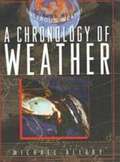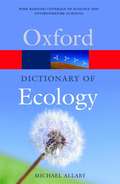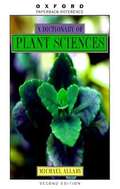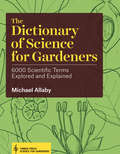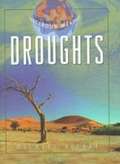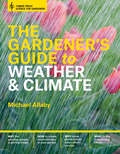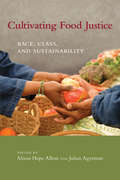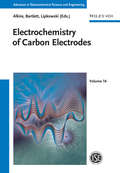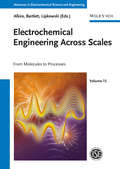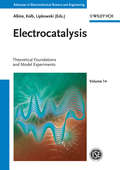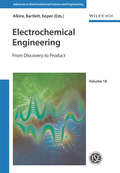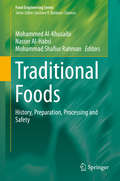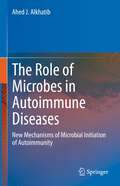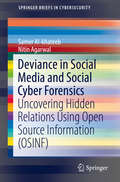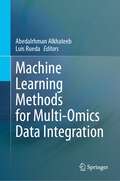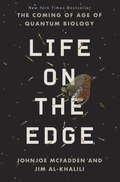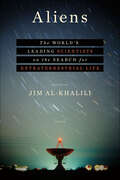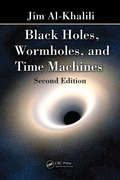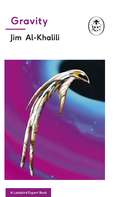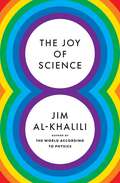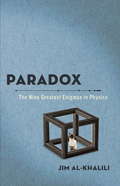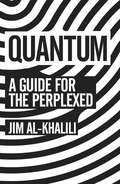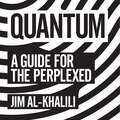- Table View
- List View
Chronology of Weather (Dangerous Weather)
by Michael AllabyFrom the Book Jacket: A Chronology of Weather presents an overview of the dangerous weather described in preceding volumes in the series. It includes a time line of catastrophic weather events from c. 3,200 B.C. to 1997, as well as a chronology of meteorological discovery-comprising the lives and inventions of great weather scientists-from c. 340 B.c. to 1995. A Chronology of Weather also contains weather experiments that students can perform at home using ordinary household supplies, a glossary of meteorological terms, charts for wind measurement and cloud classification, and further readings suggested by the author. The Dangerous Weather series imparts fundamental weather science to readers through author Michael Allaby's vivid descriptions of extreme weather systems. The series focuses on the five most dangerous kinds of weather activity; diagrams related meteorological, climatological, and environmental basics in clear, compelling language; chronicles the history of each form of dangerous weather; and offers safety precautions for extreme weather conditions. Fully illustrated and indexed, the Dangerous Weather series is an invaluable tool for student research. Other volumes include: hurricanes tornadoes droughts blizzards floods Other books in this series are also available from Bookshare.
A Dictionary of Ecology (3rd edition)
by Michael Allaby"This dictionary contains over 5,200 entries on all aspects of ecology and related disciplines. Ideal for students of biology, ecology, environmental science, conservation studies, and the general reader with an interest in the natural world and a concern about its future." "The text includes: entries on biogeography, genetics, soil science, geomorphology, atmospheric science, and oceanography; Internet links to aid further research; and over 30 new illustrations and over 200 new entries."--BOOK JACKET.
A Dictionary of Plant Sciences
by Michael AllabyThis is the most comprehensive and up-to-date paperback dictionary of botany available. Fully revised for this new edition, with over 5500 clear and concise entries, it will be invaluable to students, amateur botanists and naturalists, and everyone with an interest in plants and their environments. Wide coverage including biochemistry, plant physiology, cytology, ecology, genetics, evolution, biogeography, Earth history, and the Earth sciences. World-wide coverage of taxonomic groups - one-third of the entries are devoted to taxa, from bacteria and fungi to the main groups of flowering and non-flowering plants. Many new entries added from the field of molecular biology.
The Dictionary of Science for Gardeners: 6000 Scientific Terms Explored and Explained (Science For Gardeners Ser.)
by Michael AllabyA Library Journal Best Reference Pick of 2015! Every gardener is a scientist. Pollination, native plants, ecology, climatology—these are just a few of the scientific concepts that play a key role in a successful garden. While the ideas are intuitive to many gardeners, they are often discussed in unfamiliar scientific terms. The Dictionary of Science for Gardeners is the first of its kind to provide practical scientific descriptions for gardening terms. Highlighting 16 branches of science that are of particular interest to gardeners, with entries from abaptation to zoochory, Michael Allaby explores more than 6,000 terms in one easy-to-use reference.
Droughts (Dangerous Weather)
by Michael AllabyDucks and geese fell from the sky, choked to death by the dust through which they flew. People called the storms "black blizzards." This was the Dust Bowl of the 1930s, site of one of the worst droughts in history. Perhaps the most insidious and terrifying form of dangerous weather, the absence of rain can bring slow, lingering death to crops, animals, and humans. In Droughts readers will discover why ordinary water is the most precious substance on earth; how global climate change might affect the frequency and severity of droughts; how droughts can occur anywhere; and how to use and conserve water wisely. Stories of droughts past and recent are also recounted. The Dangerous Weather series imparts fundamental weather science to readers through author Michael Allaby's vivid descriptions of extreme weather systems. The series focuses on the five most dangerous kinds of weather activity; diagrams related meteorological, climatological, and environmental basics in clear, compelling language; chronicles the history of each form of dangerous weather; and offers safety precautions for extreme weather conditions. Fully illustrated and indexed, the Dangerous Weather series is an invaluable tool for student research. Other volumes include: blizzards, hurricanes, floods, and tornadoes. Michael Allaby is the author of more than 40 books, mainly on science, natural history, ; environmental topics. A few of his previous works include Basics of Environmental Science, How It Works: The Environment, and The Concise Oxford Dictionary of Ecology. He is a member of the New York Academy of Sciences, among other professional affiliations.
The Gardener's Guide to Weather and Climate: How to Understand the Weather and Make It Work for You (Science For Gardeners Ser.)
by Michael Allaby“We owe it to our plants to read this book. After all, while we just live with the weather, our plants have to survive it.” —The Washington Post All gardeners are at the whim of Mother Nature, and so are our plants. Whether it’s coping with extreme drought or record-breaking snow fall, gardeners—and gardens—across the country are fighting against the elements. Instead of just reacting to the weather, Michael Allaby suggests that gardeners use knowledge about how the weather works to create the best growing conditions for their plants. Allaby brings big-picture atmospheric concepts to life with a comprehensive introduction to how weather works and explanations climate change, weather systems, and microclimates. The Gardener’s Guide to Weather and Climate proves that instead of gardening at the mercy of the weather, knowledgeable gardeners can make the weather work for them
Cultivating Food Justice: Race, Class, and Sustainability (Food, Health, and the Environment)
by Alison Hope Alkon Julian AgyemanDocuments how racial and social inequalities are built into our food system, and how communities are creating environmentally sustainable and socially just alternatives.Popularized by such best-selling authors as Michael Pollan, Barbara Kingsolver, and Eric Schlosser, a growing food movement urges us to support sustainable agriculture by eating fresh food produced on local family farms. But many low-income neighborhoods and communities of color have been systematically deprived of access to healthy and sustainable food. These communities have been actively prevented from producing their own food and often live in “food deserts” where fast food is more common than fresh food. Cultivating Food Justice describes their efforts to envision and create environmentally sustainable and socially just alternatives to the food system. Bringing together insights from studies of environmental justice, sustainable agriculture, critical race theory, and food studies, Cultivating Food Justice highlights the ways race and class inequalities permeate the food system, from production to distribution to consumption. The studies offered in the book explore a range of important issues, including agricultural and land use policies that systematically disadvantage Native American, African American, Latino/a, and Asian American farmers and farmworkers; access problems in both urban and rural areas; efforts to create sustainable local food systems in low-income communities of color; and future directions for the food justice movement. These diverse accounts of the relationships among food, environmentalism, justice, race, and identity will help guide efforts to achieve a just and sustainable agriculture.
Cultivating Food Justice
by Alison Hope Alkon Julian AgyemanPopularized by such best-selling authors as Michael Pollan, Barbara Kingsolver, and Eric Schlosser, a growing food movement urges us to support sustainable agriculture by eating fresh food produced on local family farms. But many low-income neighborhoods and communities of color have been systematically deprived of access to healthy and sustainable food. These communities have been actively prevented from producing their own food and often live in "food deserts" where fast food is more common than fresh food. Cultivating Food Justice describes their efforts to envision and create environmentally sustainable and socially just alternatives to the food system. Bringing together insights from studies of environmental justice, sustainable agriculture, critical race theory, and food studies, Cultivating Food Justice highlights the ways race and class inequalities permeate the food system, from production to distribution to consumption. The studies offered in the book explore a range of important issues, including agricultural and land use policies that systematically disadvantage Native American, African American, Latino/a, and Asian American farmers and farmworkers; access problems in both urban and rural areas; efforts to create sustainable local food systems in low-income communities of color; and future directions for the food justice movement. These diverse accounts of the relationships among food, environmentalism, justice, race, and identity will help guide efforts to achieve a just and sustainable agriculture.
Electrochemistry of Carbon Electrodes
by Richard C. Alkire Jacek Lipkowski Philip N. BartlettThe book sets the standard on carbon materials for electrode design. For the first time, the leading experts in this field summarize the preparation techniques and specific characteristics together with established and potential applications of the different types of carbon-based electrodes. An introductory chapter on the properties of carbon together with chapters on the electrochemical characteristics and properties of the different modifications of carbon such as carbon nanotubes, graphene, carbon fiber, diamond or highly ordered pyrolytic graphite provide the reader with the basics on this fascinating and ubiquitous electrode material. Cutting-edge technologies such as carbon electrodes in efficient supercapacitors, Li-ion batteries and fuel cells, or electrodes prepared by screen-printing are discussed, giving a complete but concise overview about the topic. The clearly structured book helps newcomers to grasp easily the principles of carbon-based electrodes, while researchers in fundamental and applied electrochemistry will find new ideas for further research on related key technologies.
Electrochemical Engineering Across Scales, Volume 15
by Richard C. Alkire Jacek LipkowskiIn Volume XV in the series "Advances in Electrochemical Science and Engineering" various leading experts from the field of electrochemical engineering share their insights into how different experimental and computational methods are used in transferring molecular-scale discoveries into processes and products. Throughout, the focus is on the engineering problem and method of solution, rather than on the specific application, such that scientists from different backgrounds will benefit from the flow of ideas between the various subdisciplines. A must-read for anyone developing engineering tools for the next-generation design and control of electrochemical process technologies, including chemical, mechanical and electrical engineers, as well as chemists, physicists, biochemists and materials scientists.
Electrocatalysis
by Richard C. Alkire Dieter M. Kolb Jacek LipkowskiCatalysts speed up a chemical reaction or allow for reactions to take place that would not otherwise occur. The chemical nature of a catalyst and its structure are crucial for interactions with reaction intermediates. An electrocatalyst is used in an electrochemical reaction, for example in a fuel cell to produce electricity. In this case, reaction rates are also dependent on the electrode potential and the structure of the electrical double-layer. This work provides a valuable overview of this rapidly developing field by focusing on the aspects that drive the research of today and tomorrow. Key topics are discussed by leading experts, making this book a must-have for many scientists of the fi eld with backgrounds in different disciplines, including chemistry, physics, biochemistry, engineering as well as surface and materials science. This book is volume XIV in the series "Advances in Electrochemical Sciences and Engineering".
Electrochemical Engineering: From Discovery to Product (Advances in Electrochemical Sciences and Engineering #14)
by Richard C. Alkire Philip N. Bartlett Marc KoperThis volume in the "Advances in Electrochemical Sciences and Engineering" series focuses on problem-solving, illustrating how to translate basic science into engineering solutions. The book's concept is to bring together engineering solutions across the range of nano-bio-photo-micro applications, with each chapter co-authored by an academic and an industrial expert whose collaboration led to reusable methods that are relevant beyond their initial use. Examples of experimental and/or computational methods are used throughout to facilitate the task of moving atomistic-scale discoveries and understanding toward well-engineered products and processes based on electrochemical phenomena.
Traditional Foods: History, Preparation, Processing and Safety (Food Engineering Series)
by Mohammed Al-Khusaibi Nasser Al-Habsi Mohammad Shafiur RahmanThis work provides comprehensive coverage of the preparation, processing, marketing, safety and nutritional aspects of traditional foods across the globe. Individual chapters focus on the traditional foods of different cultures, with further chapters discussing the consumer acceptability of traditional foods as well as the laws and regulations and the sensorial factors driving the success of these foods. In addition, the integration of traditional food into tourism development plans is discussed at length. As the first publication to focus on a wide scale variety of traditional foods, including their histories and unique preparatory aspects, this is an important book for any researcher looking for a single reference work covering all of the important processing information for each major traditional food category. From traditional Arab foods to traditional Indian, European, African, Australian and Native American foods, Traditional Foods: History, Preparation, Processing and Safety covers the full spectrum of cultural foods, dedicating extensive information to each traditional food type. A full overview of current trends in traditional foods is included, as is a comprehensive history of each type of traditional food. Specific regulations are discussed, as are marketing factors and issues with consumer acceptability. With the recent trends in consumer interest for traditional foods which can not only bring great sensory satisfaction but also fulfill dimensions of culture and tradition, this is a well-timed and singular work that fulfills a great current need for researchers and promises to be an important source for years to come.
The Role of Microbes in Autoimmune Diseases: New Mechanisms of Microbial Initiation of Autoimmunity
by Ahed J. AlkhatibThis book provides a comprehensive, up-to-date review of the state of knowledge on the role of microbes in inducing autoimmune diseases. The initial chapters address the basic concept and clinical implications of immunology, while the following section discusses the role of genetics, epigenetics, hormones, stochastic and environmental factors in the pathogenesis of autoimmunity. The third section introduces readers to various autoimmune disorders and presents the cellular and molecular mechanisms of autoimmune diseases. In closing, the book examines the role of intestinal flora in the development of autoimmune diseases, delineates the underlying mechanism responsible for autoimmunity onset, and examines the potential of microbial therapeutics in the prevention and treatment of autoimmune diseases. Given its scope, the book offers a valuable asset for all scientists and clinicians working in immunology, rheumatology and autoimmune diseases.
Deviance in Social Media and Social Cyber Forensics: Uncovering Hidden Relations Using Open Source Information (OSINF) (SpringerBriefs in Cybersecurity)
by Samer Al-khateeb Nitin AgarwalThis book describes the methodologies and tools used to conduct social cyber forensic analysis. By applying these methodologies and tools on various events observed in the case studies contained within, their effectiveness is highlighted. They blend computational social network analysis and cyber forensic concepts and tools in order to identify and study information competitors. Through cyber forensic analysis, metadata associated with propaganda-riddled websites are extracted. This metadata assists in extracting social network information such as friends and followers along with communication network information such as networks depicting flows of information among the actors such as tweets, replies, retweets, mentions, and hyperlinks. Through computational social network analysis, the authors identify influential actors and powerful groups coordinating the disinformation campaign. A blended social cyber forensic approach allows them to study cross-media affiliations of the information competitors. For instance, narratives are framed on blogs and YouTube videos, and then Twitter and Reddit, for instance, will be used to disseminate the message. Social cyber forensic methodologies enable researchers to study the role of modern information and communication technologies (ICTs) in the evolution of information campaign and coordination. In addition to the concepts and methodologies pertaining to social cyber forensics, this book also offers a collection of resources for readers including several datasets that were collected during case studies, up-to-date reference and literature surveys in the domain, and a suite of tools that students, researchers, and practitioners alike can utilize. Most importantly, the book demands a dialogue between information science researchers, public affairs officers, and policy makers to prepare our society to deal with the lawless “wild west” of modern social information systems triggering debates and studies on cyber diplomacy.
Machine Learning Methods for Multi-Omics Data Integration
by Abedalrhman Alkhateeb Luis RuedaThe advancement of biomedical engineering has enabled the generation of multi-omics data by developing high-throughput technologies, such as next-generation sequencing, mass spectrometry, and microarrays. Large-scale data sets for multiple omics platforms, including genomics, transcriptomics, proteomics, and metabolomics, have become more accessible and cost-effective over time. Integrating multi-omics data has become increasingly important in many research fields, such as bioinformatics, genomics, and systems biology. This integration allows researchers to understand complex interactions between biological molecules and pathways. It enables us to comprehensively understand complex biological systems, leading to new insights into disease mechanisms, drug discovery, and personalized medicine. Still, integrating various heterogeneous data types into a single learning model also comes with challenges. In this regard, learning algorithms have been vital in analyzing and integrating these large-scale heterogeneous data sets into one learning model. This book overviews the latest multi-omics technologies, machine learning techniques for data integration, and multi-omics databases for validation. It covers different types of learning for supervised and unsupervised learning techniques, including standard classifiers, deep learning, tensor factorization, ensemble learning, and clustering, among others. The book categorizes different levels of integrations, ranging from early, middle, or late-stage among multi-view models. The underlying models target different objectives, such as knowledge discovery, pattern recognition, disease-related biomarkers, and validation tools for multi-omics data. Finally, the book emphasizes practical applications and case studies, making it an essential resource for researchers and practitioners looking to apply machine learning to their multi-omics data sets. The book covers data preprocessing, feature selection, and model evaluation, providing readers with a practical guide to implementing machine learning techniques on various multi-omics data sets.
Life on the Edge: The Coming of Age of Quantum Biology
by Jim Al-Khalili Johnjoe McfaddenLife is the most extraordinary phenomenon in the known universe; but how did it come to be? Even in an age of cloning and artificial biology, the remarkable truth remains: nobody has ever made anything living entirely out of dead material. Life remains the only way to make life. Are we still missing a vital ingredient in its creation? Like Richard Dawkins' The Selfish Gene, which provided a new perspective on how evolution works, Life on the Edge alters our understanding of our world's fundamental dynamics. Bringing together first-hand experience at the cutting edge of science with unparalleled gifts of explanation, Jim Al-Khalili and Johnjoe Macfadden reveal that missing ingredient to be quantum mechanics; the phenomena that lie at the heart of this most mysterious of sciences. Drawing on recent ground-breaking experiments around the world, each chapter in Life on the Edge engages by illustrating one of life's puzzles: How do migrating birds know where to go? How do we really smell the scent of a rose? How do our genes copy themselves with such precision? Life on the Edge accessibly reveals how quantum mechanics can answer these probing questions of the universe. Guiding the reader through the rapidly unfolding discoveries of the last few years, Al-Khalili and McFadden communicate the excitement of the explosive new field of quantum biology and its potentially revolutionary applications, while offering insights into the biggest puzzle of all: what is life? As they brilliantly demonstrate in these groundbreaking pages, life exists on the quantum edge.From the Hardcover edition.
Aliens: The World's Leading Scientists on the Search for Extraterrestrial Life
by Jim Al-KhaliliIn these lively and fascinating essays edited by theoretical physicist Jim Al-Khalili, scientists from around the world weigh in on the latest advances in the search for intelligent life in the universe and discuss just what that might look like. Since 2000, science has seen a surge in data and interest on several fronts related to E.T. (extraterrestrials); A.I. (artificial intelligence); and SETI (search for extraterrestrial intelligence). The debate has intensified over whether life exists outside our solar system, what that life would look like, and whether we’ll ever make contact.Included here are essays from a broad spectrum of the scientific community: cosmologists, astrophysicists, NASA planetary scientists, and geneticists, to name just a few, discussing the latest research and theories relating to alien life. Some of the topics include: If life exists somewhere in space, what are the odds that it evolves into something we would recognize as intelligent? What will space travel look like in the future, and will it all be done by cyborg technology? How long until we are ruled by robot overlords? (This is actually a serious consideration.) Are we simply a simulation in the mind of some supreme being, acting out a virtual reality game?For those who have ever wondered, Is there anybody out there? here are the latest theories and evidence that move us closer to answering that question.
Black Holes, Wormholes and Time Machines
by Jim Al-KhaliliBringing the material up to date, Black Holes, Wormholes and Time Machines, Second Edition captures the new ideas and discoveries made in physics since the publication of the best-selling first edition. While retaining the popular format and style of its predecessor, this edition explores the latest developments in high-energy astroparticle physics
Gravity: A Ladybird Expert Book
by Jim Al-KhaliliHow does gravity work? Learn from the experts in the ALL-NEW LADYBIRD EXPERT SERIESDiscover the vast and momentus effects of this profound force on the world around us, written by celebrated physicist and broadcaster Jim Al-Khalili.Inside you will learn:- What is Gravity?- How does it work?- And why are there extreme gravitational environments?Above all, discover how gravity controls the shape of space and the passage of time itself, influencing the history and destiny of the entire Universe.IT'S SO MUCH MORE THAN 'WHAT GOES UP MUST COME DOWN.'Gravity is a fascinating and authoritative introduction to a phenomenon as familiar to us as breathing.Learn about other topics in the Ladybird Experts series including The Big Bang, Quantum Physics, Climate Change and Evolution.
The Joy of Science
by Jim Al-KhaliliQuantum physicist, New York Times bestselling author, and BBC host Jim Al-Khalili reveals how 8 lessons from the heart of science can help you get the most out of lifeToday’s world is unpredictable and full of contradictions, and navigating its complexities while trying to make the best decisions is far from easy. The Joy of Science presents 8 short lessons on how to unlock the clarity, empowerment, and joy of thinking and living a little more scientifically.In this brief guide to leading a more rational life, acclaimed physicist Jim Al-Khalili invites readers to engage with the world as scientists have been trained to do. The scientific method has served humankind well in its quest to see things as they really are, and underpinning the scientific method are core principles that can help us all navigate modern life more confidently. Discussing the nature of truth and uncertainty, the role of doubt, the pros and cons of simplification, the value of guarding against bias, the importance of evidence-based thinking, and more, Al-Khalili shows how the powerful ideas at the heart of the scientific method are deeply relevant to the complicated times we live in and the difficult choices we make.Read this book and discover the joy of science. It will empower you to think more objectively, see through the fog of your own preexisting beliefs, and lead a more fulfilling life.
Paradox
by Jim Al-KhaliliA fun and fascinating look at great scientific paradoxes. Throughout history, scientists have come up with theories and ideas that just don't seem to make sense. These we call paradoxes. The paradoxes Al-Khalili offers are drawn chiefly from physics and astronomy and represent those that have stumped some of the finest minds. For example, how can a cat be both dead and alive at the same time? Why will Achilles never beat a tortoise in a race, no matter how fast he runs? And how can a person be ten years older than his twin? With elegant explanations that bring the reader inside the mind of those who've developed them, Al-Khalili helps us to see that, in fact, paradoxes can be solved if seen from the right angle. Just as surely as Al-Khalili narrates the enduring fascination of these classic paradoxes, he reveals their underlying logic. In doing so, he brings to life a select group of the most exciting concepts in human knowledge. Paradox is mind-expanding fun.
Quantum: A Guide For The Perplexed (Mapping Science Ser.)
by Jim Al-KhaliliFrom Schrodinger's cat to Heisenberg's uncertainty principle, this book untangles the weirdness of the quantum world.Quantum mechanics underpins modern science and provides us with a blueprint for reality itself. And yet it has been said that if you're not shocked by it, you don't understand it. But is quantum physics really so unknowable? Is reality really so strange? And just how can cats be half-alive and half-dead at the same time?Our journey into the quantum begins with nature's own conjuring trick, in which we discover that atoms -- contrary to the rules of everyday experience -- can exist in two locations at once. To understand this we travel back to the dawn of the twentieth century and witness the birth of quantum theory, which over the next one hundred years was to overthrow so many of our deeply held notions about the nature of our universe. Scientists and philosophers have been left grappling with its implications every since.
Quantum: A Guide For The Perplexed
by Jim Al-KhaliliFrom Schrodinger's cat to Heisenberg's uncertainty principle, this book untangles the weirdness of the quantum world.Quantum mechanics underpins modern science and provides us with a blueprint for reality itself. And yet it has been said that if you're not shocked by it, you don't understand it. But is quantum physics really so unknowable? Is reality really so strange? And just how can cats be half-alive and half-dead at the same time?Our journey into the quantum begins with nature's own conjuring trick, in which we discover that atoms -- contrary to the rules of everyday experience -- can exist in two locations at once. To understand this we travel back to the dawn of the twentieth century and witness the birth of quantum theory, which over the next one hundred years was to overthrow so many of our deeply held notions about the nature of our universe. Scientists and philosophers have been left grappling with its implications every since.
Quantum: A Guide For The Perplexed
by Jim Al-KhaliliFrom Schrodinger's cat to Heisenberg's uncertainty principle, this book untangles the weirdness of the quantum world.Quantum mechanics underpins modern science and provides us with a blueprint for reality itself. And yet it has been said that if you're not shocked by it, you don't understand it. But is quantum physics really so unknowable? Is reality really so strange? And just how can cats be half-alive and half-dead at the same time?Our journey into the quantum begins with nature's own conjuring trick, in which we discover that atoms -- contrary to the rules of everyday experience -- can exist in two locations at once. To understand this we travel back to the dawn of the twentieth century and witness the birth of quantum theory, which over the next one hundred years was to overthrow so many of our deeply held notions about the nature of our universe. Scientists and philosophers have been left grappling with its implications every since.Read by Hugh Kermode(p) 2016 Orion Publishing Group
